|
FAQs about Non-Vertebrate Animal Identification
66
Related Articles: Marine Invertebrates, Marine Invertebrate Systems, Marine Invertebrate Compatibility,
Marine Invertebrate Disease,
Marine Invertebrate
Reproduction, Quarantine of Corals and
Invertebrates, Feeding
Reef Invertebrates, Lighting
Marine Invertebrates,
Water
Flow, How Much is Enough,
Related FAQs: Non-Vert IDs 1, Non-Vert IDs 2, Non-Vert IDs 3, Non-Vert IDs 4, Non-Vert IDs 5, Non-Vert IDs 6, Non-Vert IDs 7, Non-Vert IDs 8, Non-Vert IDs 9, Non-Vert IDs 10, Non-Vert IDs 11, Non-Vert IDs 12, Non-Vert IDs 13, Non-Vert IDs 14, Non-Vert IDs 15, Non-Vert IDs 16, Non-Vert IDs 17, Non-Vert IDs 18, Non-Vert. ID 19, Non-Vert. ID 20, Non-Vert. ID 21, Non-Vert. ID 22, Non-Vert. ID 23, Non-Vert. ID 25, Non-Vert ID 26, Non-Vert ID 27, Non-Vert ID 28, Non-Vert ID 29, Non-Vert ID 30, Non-Vert ID 31, Non-Vert ID 32, Non-Vert 33, Non-Vert ID 34 Non-Vert ID 35, Non-Vert ID 36, Non-Vert ID 37, Non-Vert ID 38, Non-Vert ID 39, Non-Vert ID 40, Non-Vert ID 41, Non-Vert ID 42, Non-Vert ID 43, Non-Vert ID 44, Non-Vert ID 45, Non-Vert ID 46, Non-Vert ID 47, Non-Vert ID 48, Non-Vert ID 49, Non-Vert ID 50, Non-Vert ID 51, Non-Vert ID 52, Non-Vert ID 53, Non-Vert ID 54, Non-Vert ID 55,
Non-Vert ID 56, Non-Vert ID
57, Non-Vert ID 58,
Non-Vert ID 59,
Non-Vert ID 60,
Non-Vert ID 61,
Non-Vert ID 62, Non-Vert ID 63,
Non-Vert ID 64,
Non-Vert ID 65,
Non-Vert ID 67, Non-Vert ID 68,
Non-Vert ID 69,
& Marine Invertebrates,
Marine Invert.s 2,
Marine Invert.s 3, & FAQs about:
Marine Invertebrate Behavior,
Marine Invertebrate
Compatibility, Marine
Invertebrate Selection, Marine
Invertebrate Systems, Feeding
Reef Invertebrates, Marine
Invertebrate Disease, Marine
Invertebrate Reproduction, &
& LR
Life Identification, LR Hitchhiker ID
1, Anemone Identification,
Aiptasia
Identification, Aiptasia ID 2,
Worm Identification, Tubeworm ID, Polychaete Identification, Snail Identification, Marine Crab
Identification, Marine Invert.s 1,
Marine Invert.s 2, Marine Plankton,
|
|
|
Identify? 5/21/18
Hi Bob
Can you tell me what the yellow Lacy looking area is?
<A boring sponge of some sort Tracy... drilling into the coral. BobF>
Thanks!
|
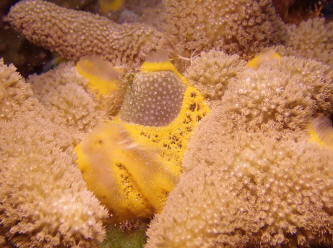 |
|
Some Help Identifying this 4/21/18
Thoughts on what these might be?
<Curious>
I had a bad feeling I had the dreaded black bugs. But I read those are arthropod
of some sort.
<Yes>
But I think this is some kind of AEFW? They have the hallmarks of a
flatworm.
<In some ways; yes. The "eyes" structures, flexible body; absence of appendages.
Worm like>
They are blacker than the AEFW I’ve seen before and smaller. I saw them on one
of my Acros so I dipped them and put these under the microscope.
<Ahh>
The AEFW I’ve seen are about the size of small rice, these are the size
of fine black pepper.
I didn't have the software to measure them under my scope.
<This is close enough>
The second half of the video is more interesting.
<Yes... and that little tail... What dip, procedure did you employ? Bob Fenner>
Nathan
|
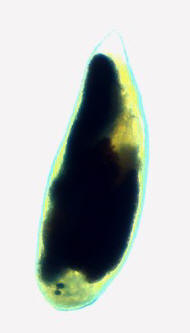
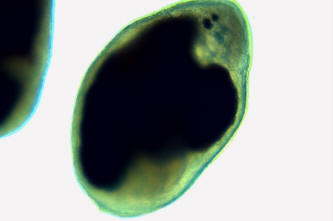 |
|
Re: Some Help Identifying this 4/21/18
Bayer Advanced Complete Insect Killer for Soil and Turf
Concentrate. 2.5 gallons of water with 400 mL of Bayer. 15 min, then I
perfuse tank water into the dip container letting the overflow go down the
drain.
Then I dip in Revive for about 10 min - not sure why other
than it seems to make the coral “slime up” and then more things come off
when I do the final rinse.
<A common occurrence>
Final rinse off with tank water and put the coral back in the tank.
<Good>
So far not coral loss and the “bugs” drop off pretty darn fast.
<With the use of Bayer and ReVive most all should be eliminated. Am not sure
what these are; or if they're predaceous pests or no. Bob Fenner>
Re: Some Help Identifying this /Lynn's input
4/22/18
Hey Bob! It's good to hear from you. Things are going well here. We're now
loving life in beautiful Colorado after being flooded out in hurricane Harvey.
This was a case of being gifted with a beautiful rainbow after the storm! I hope
all is going great for you as well. I just saw the attached query and will get
on it right now. Take care, Lynn
<Ah; great to hear from you and realize you're doing well Lynn. Cheers, BobF>
<<Thanks, Bob. Life is good! As for the queried subject, I've looked everywhere
and can't offer anything beyond what you've already stated and recommended.
Hopefully, I'll be more help with the next ID! Take care, Lynn>>
>Thank you Lynn. A mystery for sure. BobF<
|
|
Flatworm or something else?
4/11/18
Hi WWM Crew,
<Adam>
Was hoping to get an ID on the mysterious creatures in the attached photos.
<Appear to be Acoel flatworms... Likely no big deal. See WWM re>
Thanks for your help!
Adam Clayton
<Welcome. Bob Fenner>
|
.jpeg)
 crop
crop |
|
Hitchhiker ID 3/24/18
Hi again all! I have a few hitchhikers on some Caribbean live rock that I'm
hoping to identify, if you'd be willing to lend an eye and an opinion. I think
the anemone is an Anemonia melanaster and the sponge I believe to be
Mycale laxissima, but I know sponge identification is dodgy at best without a
microscope.
<Even with at times>
The coral at its base looks to me like Eusmilia fastigiata, smooth flower coral.
Do you feel I'm way off base on any of these? If so, what are they? I'd really
appreciate your input. This is a brand new tank, still cycling so there are no
fish or intentional inverts in there yet.
All the rock has been sourced from Caribbean suppliers.
Leah
<Leah, we ask/require that people send in files of no more than a few hundred
Kbytes... you've sent 13 megs. And these pix are too washed out, poorly resolved
to make out much. Please reshoot, re-size and re-send. Bob
Fenner>
Re: Hitchhiker ID 3/25/18
Sorry about that, all I have to take pictures is my phone and I didn't realize
it saved pictures as such large files.
<Ahh! And we have quite limited email storage total; and when out in places w/
slow Net... Agonizing!>
I found an app to resize photos, please let me know if these work out better.
<Ah yes. The first... does it really have a stony base? To me
it looks like a Glass Anemone/Aiptasiid; and the second; are you referring to
the pinkish Sea Squirt or the stony coral under it? If the coral it may be a cup
coral/Eusmilia, Caryophylliid of the trop. W. Atlantic Bob Fenner>
|
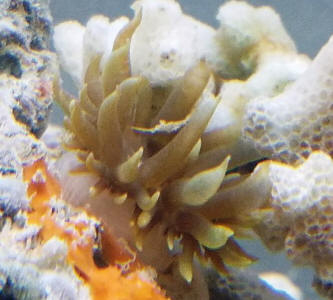
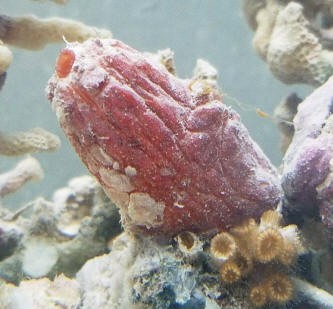 |
|
Re: Hitchhiker ID 3/25/18
It is on a solid stony base, not in a crevasse or hole in the rock.
<But does the animal itself display a coral skeleton? Anemones do not>
I did not immediately think Aiptasiid for two reasons: first, when disturbed it
pulls it's tentacles and oral disc down into it's rather fat column but does not
pull into the rock at all (and indeed cannot because of its placement) and
second, the tentacles keep bulbing up very similar to a BTA.
Are these behaviors Aiptasiids share?
<Can be; yes. They are quickly retractile, and do have bulging tentacles at
times... Try using Google to see images, or WWM! >
I've never had them before so I only have "book learning" on them unfortunately.
<Are to be found looking about in the TWA. BobF>
Re: Hitchhiker ID 3/25/18
You're often a better resource than Google lol. I did look up quite a few images
on Google image search and in various databases but i haven't made it through
the WWM FAQs so I will keep looking! Thanks so much for your help!
<Glad to assist you Leah; hoping we can solve this mystery. Bob Fenner>
|
|
Can you Id this? 3/17/18
Hello Bob and WetWetMedia Friends,
<Hey Raul>
I took a picture of a Berghia Nudibranch and I noticed something else on the
picture.
<Nice pix!>
Something I have seen over some mushrooms.
Can you identify the thing the arrow is pointing at, that you can see covering
the mushrooms in the other 2 pictures?
<Oh yeah>
Is it a plague? A parasite? Or is something normal the mushrooms have?
<These are flatworms... some folks lose their minds launching attacks against
such... best to be patient, perhaps add a biological control (predator). Let's
have you read here:
http://www.wetwebmedia.com/flatworms.htm
and the linked files above re>
Thank you.
Best regards,
Raul Labastida
<Welcome! Bob Fenner>
|
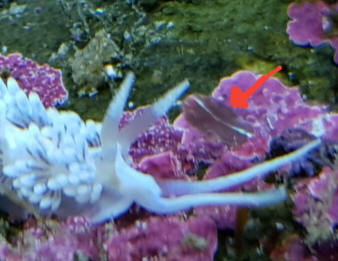
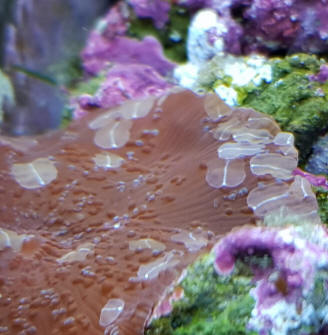 |
|
Re: Can you Id this?
Acoels 3/18/18
Thank you Bob,
<Welcome Raul>
I really appreciate your help.
<Glad to render it>
I read all the articles and even searched in 2 forums.
I think I will go with your recommendation and be patient (Patient is the second
name of Reefkeeping) as all the possible solutions are very hard to implement in
my tank.
<Ah yes; this is what I'd do as well. Have seen much more concentrated
aggregations of these Acoels on Mushrooms et al Cnidarians in the wild>
I was able to find and Buy some Berghia Nudibranchs to eliminate all the
Aiptasia I had.
If I can find a Velvet Sea Slug - Chelidonura varians I will try with it as it
seems to be the best and safest option.
If you can recommend something else please let me know.
<Nothing more. Nada mas>
Thank you again
Best regards,
Raúl Labastida
<And you. BobF>
|
|
Red algae ID 2/11/18
Hello, I wrote in many months back and you were super helpful identifying some
algae for me. I hope you can help again! I have attached a photo of the reddish
pink tree-like algae that is spreading like wildfire through my tank. I didn’t
see anything like it in your algae ID archives... can you tell me what it is?
<I wish I could... the regular branching... I don't think this is an algae/Thallophyte,
but a very pink Hydrozoan of some sort>
Does anything eat it that I could use to help control the spread? Thank you!
-Sarah
<There are some notable Seaslugs that ingest various Hydropolyps, but I don't
know anything re this particular one. I would remove it from the system, as it
may be producing stinging elements that will bother your other livestock. Do you
have a microscope with a USB connection? I'd like to see some 100-200, 400 time
magnification shots. Bob Fenner>
|

 |
|
Re: Red algae ID 2/12/18
Hi Bob, I don’t have a microscope unfortunately.
<Perhaps a local fish store does, someone from a marine aquarium club>
I have tried some manual removal but ripping it off leaves traces behind
that I cannot remove, and it is widespread, including my tank overflow box
and powerhead. It also grows very very fast.
<Yeeikes! I wish I could tell definitive what this is. I have never
encountered something this shade of pink, nor with the array of branching it
shows>
Is bleaching my tank and starting over my only option to eradicate this
pest?
<It may well be>
Also, can it sting fish or just corals?
<Can't tell w/o testing or microscopic looking. BobF>
Thanks again.
Sarah
|
|
Help with jelly infestation on Coral system
1/9/18
Hi Bob,
<Raul>
I visited this weekend some friends that have a Fish and Coral store.
<Ahh>
They are having some kind of Jelly infestation in their coral Beds and need
urgent help.
<No fun>
I've never seen something like this before.
I took some small videos that show the issue. Is there a way I can send them to
you so maybe you and other WWM experts can help with this problem?
I could send pictures but the videos show much better the problem.
<Please post on YouTube (or such) and send along the link. We have limited file
space from our ISP>
Please help me to give them a solution.
Thank you.
Best regards,
Raúl Labastida
<I can tell you in general what the choices are... finding where the jellies are
strobilizing from (rock usually) and removing them "by the roots" (scraping and
vacuuming); and for ones in suspension, VIGOROUS water movement, mechanical
filtration that removes them readily from the system. No chemical treatment,
predators... will work here. Bob Fenner>
Estado de Mexico
México
Re: Help with jelly infestation on Coral system... Hydroids? 1/9/18
Hi Bob,
I call it jelly for not having any other way to call it. I don't know what it
is.
<Okay....>
As you can see on their first Triton Test (attached) from December 27 when this
problem was starting their water parameters are not that bad.
<I agree>
Please find the links to YouTube for 2 short videos:
https://youtu.be/Jtbj_26mQQc
https://youtu.be/r795Z4yisg4
It's like gelatinous strings with bubbles that raise from the corals and all
other surfaces.
<Mmm; this may be... a Hydrozoan... but need a much closer, better resolved
image to tell. Preferably a few ten power microscope shot. Otherwise... there
are MANY possibilities for what this might be. I don't see marks on the
fishes... which leads me to think this isn't likely a very toxic thing at any
length. But; do have your friends look up "Hydrozoan", "Hydropolyp", "Myrionema"
for some input possibility>
Hope this helps to show you what I mean.
<Not really mate>
Thank you.
Best regards,
Raúl Labastida
<Welcome. BobF>
Re: Help with jelly infestation on Coral system
1/9/18
Hello Bob,
<Raul>
Thank you for the info.
<W>
I took the attached pictures of the gelatinous thing.
You can see how its on corals like a spider web and it is white when is inside
the water. But if you take it out it turns reddish as you can see on the other
picture.
<... five megs of gelatinous....>
I will try to get better 10X zoom pictures tomorrow.
<Good>
Let me know if the attached pictures help.
<They don't>
Thank you.
Best regards,
Raúl Labastida
|
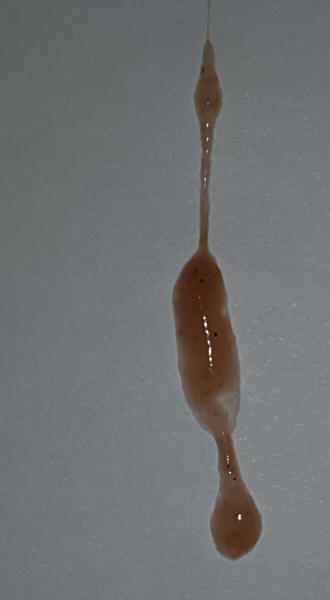
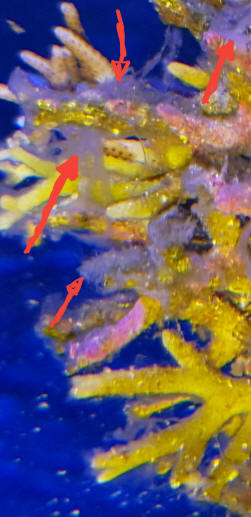 |
|
|

